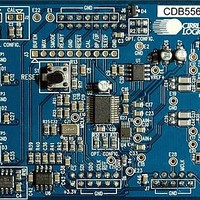CDB5566 Cirrus Logic Inc, CDB5566 Datasheet - Page 15

CDB5566
Manufacturer Part Number
CDB5566
Description
Dev Bd For I/C 24-bit, Diff, 5kSPS, DAQ
Manufacturer
Cirrus Logic Inc
Type
A/Dr
Specifications of CDB5566
Number Of Adc's
1
Number Of Bits
24
Sampling Rate (per Second)
5k
Data Interface
SPI™
Inputs Per Adc
2 Differential
Input Range
0 ~ 4.096 V
Power (typ) @ Conditions
20mW @ 5kSPS
Voltage Supply Source
Analog and Digital, Dual ±
Operating Temperature
-40°C ~ 85°C
Utilized Ic / Part
CS5566
Conversion Rate
5 KSPS
Resolution
24 bit
Maximum Clock Frequency
8 MHz
Interface Type
SPI
Supply Voltage (max)
3.3 V
Supply Voltage (min)
- 2.5 V
Product
Data Conversion Development Tools
Lead Free Status / RoHS Status
Contains lead / RoHS non-compliant
For Use With/related Products
CS5566
Lead Free Status / RoHS Status
Contains lead / RoHS non-compliant
Other names
598-1557
CDB-5566
CDB-5566
3.2 Power Consumption
The power consumption of the CS5566 converter is a function of the conversion rate.
the typical power consumption of the converter when operating from either MCLK = 8 MHz or
MCLK = 4 MHz. The rate at which conversions are performed directly affects the power consumption.
When the converter is powered but not converting, it is in an idle state where its power consumption is
about 11 mW. When the CONV signal goes low to start a conversion, the converter delays the actual start
of conversion for 1182 to 1186 MCLK cycles, depending upon how CONV is controlled. The timing for the
conversion sequence is shown in
CONV goes low, the converter enters a higher-power state for 354 MCLK cycles and then returns to a
lower-power state for 64 MCLK cycles, after which the RDY signal falls to indicate the completion of a
conversion. Since the peak operating current for the converter occurs during the 354 MCLK, higher-pow-
er state, it is recommended that a large capacitor be used on the supply to the converter (as shown in
Figures 9 and 10). This capacitor filters the peak current demand from the power supply. The average
power consumption for the converter will depend upon the frequency of MCLK and the rate at which con-
versions are performed as illustrated in
DS806PP1
17.5
12.5
7.5
20
15
10
0
Figure 6. Power Consumption vs. Conversion Rate
500
1k
Figure 1
MCLK = 4MHz
Figure 1
1.5
on page 6. After the 1182 - 1186 MCLK delay from when
Word Rate (Sps)
3/25/08
2k 2.5k 3k 3.5k 4k 4.5k 5k
on page 6.
MCLK = 8MHz
Figure 6
CS5566
illustrates
15



















